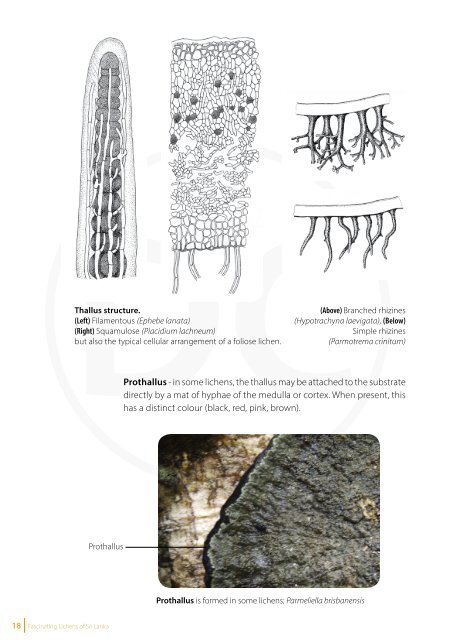You also want an ePaper? Increase the reach of your titles
YUMPU automatically turns print PDFs into web optimized ePapers that Google loves.
Types <strong>of</strong> <strong>Lichens</strong><br />
The vegetative structure <strong>of</strong> the lichen has developed to a complexity that has<br />
not yet been reached by any other group in the fungal kingdom. Consequently,<br />
lichens come in many colours and have various structures. In general, lichens are<br />
subdivided into several growth forms. These forms are used for convenience <strong>of</strong><br />
categorizing lichens and have no taxonomic basis. Thus, each form could include<br />
very different unrelated families and genera, and conversely, a single family or a<br />
genus could span several growth forms.<br />
Initially, lichens can be categorized as microlichens and macrolichens based on<br />
the size <strong>of</strong> the thallus. Based on the habit <strong>of</strong> lichens, all <strong>of</strong> them can be integrated<br />
within the threefold artificial scheme <strong>of</strong> growth forms viz. crustose, foliose and<br />
fruticose. The simplest growth form, crustose lichens, is principally considered as<br />
a microlichen. Usually smaller, flat patches on bark or rock are crustose. They are<br />
closely attached to the substrate growing directly on the surface with the lower<br />
surface tightly attached, so water loss is restricted to the upper surface.<br />
Lichen species with more complex, larger and more conspicuous growth forms<br />
are termed as macrolichens and mainly include the foliose and fruticose lichens.<br />
Thallus structure.<br />
(Left) Filamentous (Ephebe lanata)<br />
(Right) Squamulose (Placidium lachneum)<br />
but also the typical cellular arrangement <strong>of</strong> a foliose lichen.<br />
(Above) Branched rhizines<br />
(Hypotrachyna laevigata), (Below)<br />
Simple rhizines<br />
(Parmotrema crinitum)<br />
Foliose lichens have a leaf-like, flattened, partially attached thallus that expands<br />
and spreads horizontally. The thallus is usually attached to the substrate by<br />
rhizines present on the lower surface, consisting <strong>of</strong> a root-like hair that may be<br />
simple, dichotomously, or irregularly divided and grow centrifugally outwards.<br />
Prothallus<br />
Prothallus - in some lichens, the thallus may be attached to the substrate<br />
directly by a mat <strong>of</strong> hyphae <strong>of</strong> the medulla or cortex. When present, this<br />
has a distinct colour (black, red, pink, brown).<br />
Fruticose lichens have upright, bushy or shrubby growth or pendulous, hairlike<br />
or strap-shaped growth by which the thallus is attached to the substrate<br />
at the base (by a holdfast). In fruticose lichens, the upper cortex goes all the<br />
way around the branches or stalks, so there is no upper or lower surface. The<br />
photobiont layer is found below the cortex, and the medulla lies deeper within.<br />
There are two types <strong>of</strong> fruticose thalli: radiate-fruticose (e.g. Usnea) and stratosefruticose<br />
(e.g. Cladonia). Some fruticose lichens have a solid interior while some<br />
genera have a hollow interior (Cladonia). <strong>Lichens</strong> which belong to genus Usnea<br />
have an elastic central cord.<br />
Some species with tiny, crowded, <strong>of</strong>ten overlapping lobes called squamules are<br />
<strong>of</strong>ten referred to as squamulose. These have been grouped with the crustose<br />
species except for those in Cladonia, a special case. Most Cladonia species have a<br />
base consisting <strong>of</strong> a mass <strong>of</strong> squamules, the primary thallus from which single or<br />
branched stalks arise, called podetia that are essentially fruticose. So this genus<br />
has been placed with the other fruticose genera.<br />
Prothallus is formed in some lichens; Parmeliella brisbanensis<br />
18 <strong>Fascinating</strong> <strong>Lichens</strong> <strong>of</strong> <strong>Sri</strong> <strong>Lanka</strong><br />
<strong>Fascinating</strong> <strong>Lichens</strong> <strong>of</strong> <strong>Sri</strong> <strong>Lanka</strong> 19















